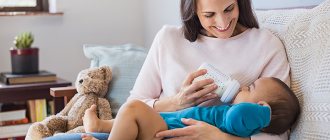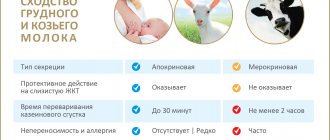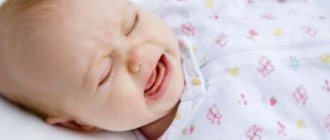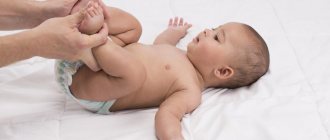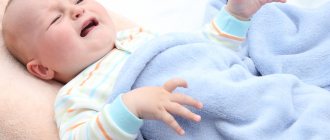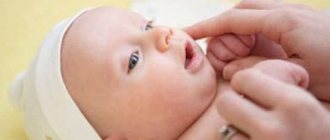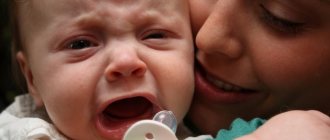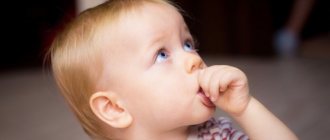Development of the grasping reflex in infants
Children's grasp reflex is an innate ability, but it will take them at least a year to develop coordination and securely grasp and hold things in their hands. Typically, they begin actively working on developing this skill by 12 weeks and improve it every month.
Infants up to 2 months
Touch your child's hand and he will wrap his tiny fingers around yours. This is an innate reflex inherent in every baby. But during the first eight weeks these movements are instinctive and involuntary.
During this period, the baby's hands will mostly be clenched into a fist, but soon he will begin to deliberately open and close them, as well as examine them. He may even try to grasp objects such as stuffed animals, these are the basic grasping reflexes of a newborn.
3 month old babies
The grasping reflexes of a 3-month-old baby are manifested in the fact that he still cannot grab what he wants, but the baby will hit the toys again and again. He also develops hand-eye coordination by noticing things he wants to hold and trying to reach them. Lying on a soft developmental baby mat, your baby can brush away the funny toys hanging above him.
Infants from 4 to 8 months
At 4 months, the baby can pick up large objects, such as cubes. However, her grasping reflex does not yet allow her to pick up small objects, such as peas; her fingers will not become more dexterous until they become more dexterous.
Shortly before her first baby tooth comes out (usually between 4 and 7 months), your baby will start picking up objects here and there to put in her mouth. If she is already eating solid food, she may not yet be able to hold a baby spoon steady in her hands, but she will diligently try to do so.
She can grab objects toward her and begin moving them from one hand to the other. Therefore, it is now necessary to keep all valuables out of her reach, and also to ensure that the house is sufficiently protected from small objects that she might swallow while she develops a new level of grasping reflexes.
Development of the grasping reflex in a child from 9 to 12 months
With a little effort, the child will now be able to lift objects. His preference for his left or right hand will begin to appear. However, you won't be able to definitively determine his dominant hand until he is 2 or 3 years old.
He also improves his grip, allowing him to pick up small objects by pinching them between his thumb and index finger.
Having improved his coordination, your child will soon be able to use a spoon or fork to eat, although at this stage of development he may prefer to hold the utensil in one hand while eating with his fingers in the other. You may have to help him hold a spoon or fork, showing him how to use it. But he will learn faster if you allow him to make several independent attempts at each meal.
Congenital reflexes of a newborn
- Newborn
- Physiological reflexes
- Sucking reflex
Newbornhood is the only period in a person’s life when natural, instinctive forms of behavior can still be observed in their pure form.
Therefore, the answer to the question “what does nature give to a child?” can be obtained by studying exactly this age. A baby is born with a certain supply of innate unconditioned reflexes, that is, automatic, involuntary responses to certain external stimuli. And although his nervous system is still far from formed, it is ready to adapt the body to external conditions.
Among the innate reflexes of a newborn, three groups can be distinguished: physiological, atavistic and orientation reflexes.
A child is born with reflexes that are absolutely necessary for his physical survival in the outside world. These are physiological reflexes. So, immediately after birth, reflexes are activated that ensure breathing and blood circulation. This group also includes the so-called protective reflexes, which protect the body from dangerous and too strong influences.
Thus, severe skin irritation (for example, an injection) causes the child to withdraw his arms or legs; a sharp increase in light brightness causes constriction of the pupil (pupillary reflex); In response to a flicker of light or a puff of air, the baby squints or closes his eyes (blink reflex). These reflexes are absolutely necessary for survival and persist throughout a person's life.
The most important vital reflex of a newborn is the sucking reflex. If you touch an object (for example, a finger) to the baby's mouth, he immediately begins to suck on it. And if you touch his cheek, he will immediately turn his head towards the irritant and with his mouth open will look for it. This turns on the search reflex. These reflexes ensure that the child is ready for a new type of nutrition.
However, not all reflexes of a newborn have vital adaptive significance. They represent the inheritance received by the child from his animal ancestors. Nothing human develops on their basis. These are the so-called atavistic reflexes. The most striking example of this is the so-called Robinson reflex (or clinging reflex). Touching a baby's palm produces a grasping reaction that is surprisingly strong for a newborn.
For example, if you touch his palms with your fingers, he will grab them so tightly that he can hang on to your fingers like a monkey. These also include the “stepping reflex” - if the baby’s foot touches any surface, he begins to make stepping movements with both legs, as if “walking.” Reflexes that are equally useless for the life of a newborn include the crawling reflex (touching the soles of the feet causes a reflex repulsion); arm-throwing reflex (or Moro reflex - if the baby is in danger of falling or in response to a strong sound, he sharply raises his arms up and quickly lowers them, while his palms seem ready to grab something). Relatively recently, the swimming reflex of a newborn was discovered: if he is lowered into water, he will not drown, but will flounder and stay on the water.
It is characteristic that most atavistic reflexes fade away already in the first half of life. For example, the Robinson reflex weakens significantly by the fourth month of life, before a purposeful act of grasping occurs. The step reflex disappears at 3-4 months, long before the child begins to walk. The crawling reflex when resting on the soles is also not the basis for independent movement in space. As observations have shown, infant crawling begins not with pushing off with the legs, but with movements of the arms. Unconditioned reflexes of newborns do not by themselves ensure the emergence of human forms of behavior. In contrast, a set of unconditioned reflexes of young animals is a necessary natural basis for the behavior of an adult: protective, hunting, maternal and other reactions are absolutely necessary for its normal existence.
At the same time, the unconditioned reflexes of a newborn can be included in other, more complex and purposeful forms of behavior of the child.
For example, the sucking reflex, since it is constantly exercised in a situation of interaction with the mother, at 2-3 months turns into a purposeful and regulated action of the baby. The child stops sucking everything, he begins to regulate the rhythm and intensity of sucking, he can stop it when he is full or start it at the sight of a pacifier or bottle. The same goes for the grasping, stepping or swimming reflex. If they are constantly trained and included in a situation of interaction with an adult, these movements can be preserved and become part of more complex actions (walking, grasping and holding an object, etc.).
However, these reflexes by themselves will never develop into human forms of behavior, which are formed on a completely different, non-reflexive basis. So, for example, with constant exercise of the baby’s swimming reflex (which is now often practiced by parents), the child will retain the ability to float on water and swim primitively. But from these exercises he himself will not move on to cultural styles of human swimming (that is, he will not swim breaststroke or crawl). Mastery of these styles occurs on a completely different, non-natural basis.
Newborns have another group of reflexes , which, although they do not have physiological vital significance, do not fade with age, but, on the contrary, become stronger. These are orienting reflexes aimed at contact with external influences. It has been established that already on the first day of life, a strong light source causes the baby’s head to turn: in the children’s room of a maternity hospital on a sunny day, the heads of most newborns are turned towards the light, like sunflowers. The newborn also reacts to a strong sound and turns its head towards the source of the sound. Unconditioned orientation reflexes represent the innate sensory abilities of the newborn (the ability to perceive the external world), which are the basis for the need for impressions. This need manifests itself already in the first days of life.
How to develop the grasping reflex in a child?
To stimulate the grasping reflex, place a toy or bright object near the child and encourage him to grab it. Place things so that he can reach them without getting upset. Provide him with plenty of toys that he can easily grasp with his hands, such as soft blocks, plastic rings and board books.
Later, as he improves his grip, encourage your child to pick up soft food such as peas or boiled carrots with his fingers - this is a good skill that will be useful until he masters the spoon and fork.
Important!
To avoid choking, it is recommended to keep it away from and not feed it solid foods such as nuts or raw carrots.
By the time your baby is a year and a half old, he will discover that he can put objects he picks up in larger containers. You can help develop this skill by giving him items to put in empty boxes, plastic containers, or other containers.
The child has learned to grab: what next?
- As soon as the baby learns to grasp, a new skill will appear - throwing, so be careful. Many children get incredible pleasure from throwing their toys.
- When your baby turns one year old, he will enjoy playing with a ball, making pyramids, and knocking objects together.
- When he turns one and a half years old, his creative abilities will begin to actively manifest themselves, and therefore he will be fascinated by pencils and their use for drawing and writing.
- At 3 years old, he will already be coordinated enough to try to write letters and maybe even his name.
Resting neck reflex (fencing reflex)
When the baby is lying on his back, turn his head to the side, and you will see that he will move his arm and leg in the same direction, taking the pose of a fencer preparing to attack. This reflex both promotes and inhibits muscle development. On the one hand, it encourages the child to look at his own hand and fixes his attention on the toy held in it. On the other hand, it does not allow the baby’s head, hands and toy to be in the center. By 3-4 months, this reflex disappears, and the child begins to hold toys directly in front of him to look at them or suck them.
Defense reflex
A newborn laid on his stomach turns his head to the side and tries to lift it.
Normally, after 1-1.5 months, the child tries to hold his head up on his own. In children with damage to the nervous system, the protective reflex is delayed and sometimes does not appear, for example, in a child with a natal injury to the cervical spinal cord. In children at risk for developing cerebral palsy, there may be prolonged elevation of the head and even throwing it back (due to increased tone of the neck extensors).
Perez reflex
It is caused by applying line irritation along the spinous processes from the coccyx to the neck. In response, the child’s legs are simultaneously bent and brought toward the stomach, the back is arched, the anal sphincter often opens, and urination may occur. If you induce the reflex with the child face down on the doctor’s palm, the response is a sharp cry, extension of the arms, legs, head, protrusion of the anus, and urination.
Normally, the reflex is evoked up to 3-4 months. It's better to check it last. Its suppression during the neonatal period or delayed reverse development is observed in children with damage to the central nervous system.
Based on materials from the book by O.V. Goncharova.
"Baby Care Benefit"

